Cantaloupe salad dressing: prepare to be amazed! Forget everything you thought you knew about salad dressings because this vibrant, sweet, and tangy concoction is about to revolutionize your summer salads. I know, I know, cantaloupe in a salad dressing sounds a little unexpected. But trust me on this one. This isn’t just another dressing; it’s a taste of sunshine in a bottle!
While not steeped in centuries of tradition like some vinaigrettes, cantaloupe salad dressing draws inspiration from the global appreciation for fruit in savory dishes. Think of the classic prosciutto and melon pairing, or the refreshing watermelon salads enjoyed across the Mediterranean. This dressing takes that same principle the delightful contrast of sweet and savory and elevates it to a whole new level.
What makes this dressing so irresistible? It’s the perfect balance of flavors. The natural sweetness of the cantaloupe is tempered by a bright acidity, often from lime or vinegar, creating a dressing that’s both refreshing and complex. People adore it because it’s incredibly easy to make, requiring minimal ingredients and effort. Plus, it’s a fantastic way to use up any leftover cantaloupe you might have. But most importantly, it tastes absolutely divine, transforming even the simplest salad into a gourmet experience. Get ready to experience your new favorite summer dressing!
Ingredients:
- 1 ripe cantaloupe, about 3-4 pounds
- 1/4 cup extra virgin olive oil
- 2 tablespoons apple cider vinegar (or white wine vinegar)
- 1 tablespoon honey (or maple syrup for a vegan option)
- 1 tablespoon fresh lime juice
- 1 teaspoon Dijon mustard
- 1/2 teaspoon sea salt (or to taste)
- 1/4 teaspoon black pepper (freshly ground is best)
- Optional: 1/4 teaspoon red pepper flakes (for a little kick)
- Optional: 2 tablespoons chopped fresh mint or basil
Preparing the Cantaloupe:
Okay, let’s get started! The most important part of this recipe is, of course, the cantaloupe. You want to make sure it’s perfectly ripe. Look for a cantaloupe that feels heavy for its size and has a sweet, slightly musky aroma. The stem end should have a slight give when you press it gently.
- Wash the cantaloupe thoroughly. Even though you’re not eating the rind, you want to remove any dirt or bacteria that could transfer to the flesh when you cut it. Use a clean vegetable brush and some cool water.
- Cut the cantaloupe in half. Place the cantaloupe on a cutting board and, using a large, sharp knife, carefully cut it in half from stem to blossom end.
- Remove the seeds. Use a spoon to scoop out all the seeds and the stringy fibers from the center of each half. Discard the seeds (or save them to roast later!).
- Cut the cantaloupe into chunks. Place each half cut-side down on the cutting board. Slice off the rind, following the curve of the melon. Then, cut the cantaloupe flesh into roughly 1-inch chunks. Don’t worry about making them perfectly uniform; we’re going to blend them anyway.
Making the Dressing:
Now for the fun part turning that delicious cantaloupe into a vibrant and flavorful dressing! This is super easy and quick.
- Combine the ingredients. In a blender or food processor, combine about 1 1/2 cups of the cantaloupe chunks (reserve the rest for serving, if desired), olive oil, apple cider vinegar, honey (or maple syrup), lime juice, Dijon mustard, salt, pepper, and red pepper flakes (if using).
- Blend until smooth. Blend the mixture on high speed until it’s completely smooth and creamy. This usually takes about 30-60 seconds, depending on the power of your blender.
- Taste and adjust. Give the dressing a taste and adjust the seasonings as needed. If it’s too tart, add a little more honey. If it needs more zing, add a squeeze more lime juice. If it’s not salty enough, add a pinch more salt. Don’t be afraid to experiment until you get it just right!
- Add fresh herbs (optional). If you’re using fresh mint or basil, add it to the blender now and pulse a few times to incorporate it. Be careful not to over-blend, or the herbs will turn bitter.
Storing the Dressing:
This dressing is best when it’s freshly made, but it can be stored in an airtight container in the refrigerator for up to 3 days. Keep in mind that the color may fade slightly over time, but the flavor will still be delicious.
Serving Suggestions:
Okay, so you’ve got this amazing cantaloupe dressing now what do you do with it? The possibilities are endless! Here are a few of my favorite ways to use it:
- Classic Salad: Toss it with mixed greens, crumbled feta cheese, toasted pecans or walnuts, and some of the reserved cantaloupe chunks.
- Grilled Chicken or Fish: Drizzle it over grilled chicken or fish for a light and refreshing summer meal.
- Grain Bowl: Use it as a dressing for a quinoa or farro bowl with roasted vegetables, chickpeas, and avocado.
- Pasta Salad: Toss it with cooked pasta, cherry tomatoes, cucumbers, and mozzarella balls for a vibrant pasta salad.
- Fruit Salad: Add it to a fruit salad with other melons, berries, and grapes for an extra burst of flavor.
- Caprese Salad Upgrade: Drizzle over a Caprese salad with fresh mozzarella, tomatoes, and basil. The sweetness of the cantaloupe complements the other flavors beautifully.
Tips and Variations:
- For a creamier dressing: Add a tablespoon or two of Greek yogurt or sour cream to the blender.
- For a spicier dressing: Add a pinch of cayenne pepper or a few drops of hot sauce.
- For a sweeter dressing: Use a sweeter variety of cantaloupe, such as a Charentais melon.
- For a tangier dressing: Use balsamic vinegar instead of apple cider vinegar.
- Make it vegan: Substitute maple syrup for the honey.
- Add other fruits: Blend in a few chunks of mango or pineapple for a tropical twist.
- Use different herbs: Try using cilantro, parsley, or chives instead of mint or basil.
- Adjust the consistency: If the dressing is too thick, add a little water or lime juice to thin it out. If it’s too thin, add a few more cantaloupe chunks.
Troubleshooting:
- Dressing is too bitter: This can happen if you over-blend the herbs or if the cantaloupe isn’t ripe enough. Try adding a little more honey or lime juice to balance the flavors.
- Dressing is too bland: Add more salt, pepper, or Dijon mustard to boost the flavor.
- Dressing is too watery: Make sure you’re using a ripe cantaloupe, as unripe cantaloupe can be watery. You can also add a tablespoon of chia seeds to the blender to help thicken the dressing.
Nutritional Information (approximate, per serving):
Please note that the nutritional information is an estimate and may vary depending on the specific ingredients you use.
- Calories: 80-100
- Fat: 6-8g
- Saturated Fat: 1g
- Cholesterol: 0mg
- Sodium: 100-150mg
- Carbohydrates: 8-10g
- Fiber: 1-2g
- Sugar: 6-8g
- Protein: 1g
Enjoy your homemade Cantaloupe Salad Dressing! I hope you love it as much as I do. It’s the perfect way to add a touch of summer to any meal.

Conclusion:
This isn’t just another salad dressing; it’s a vibrant burst of sunshine in a bottle! The cantaloupe salad dressing recipe I’ve shared is a game-changer, transforming even the simplest salad into a culinary delight. The sweetness of the cantaloupe, perfectly balanced with the tang of the vinegar and a hint of herbs, creates a flavor profile that’s both refreshing and sophisticated. Trust me, once you try it, you’ll never reach for store-bought dressing again.
Why is this a must-try? Because it’s incredibly easy to make, uses fresh, seasonal ingredients, and delivers a flavor explosion that will tantalize your taste buds. It’s also incredibly versatile. Imagine drizzling it over a bed of mixed greens with crumbled feta cheese and toasted pecans for a delightful lunch. Or, try it as a marinade for grilled chicken or fish the cantaloupe’s natural sugars will caramelize beautifully, creating a delicious glaze.
But the possibilities don’t stop there! For a spicier kick, add a pinch of red pepper flakes to the dressing. If you prefer a creamier texture, blend in a tablespoon of Greek yogurt or sour cream. And for a vegan option, simply substitute the honey with maple syrup or agave nectar. You can even experiment with different herbs basil, mint, or even a touch of cilantro would all work wonderfully.
Here are a few more serving suggestions to get your creative juices flowing:
* Caprese Salad Upgrade: Drizzle this dressing over a classic Caprese salad (tomatoes, mozzarella, and basil) for a sweet and savory twist.
* Fruit Salad Booster: Add a spoonful to your favorite fruit salad to enhance the natural sweetness and create a more cohesive flavor profile.
* Grain Bowl Glam-Up: Use it as a dressing for quinoa or farro bowls with roasted vegetables and chickpeas.
* Slaw Sensation: Toss it with shredded cabbage, carrots, and red onion for a light and refreshing slaw.
* Avocado Toast Topper: Drizzle a small amount over avocado toast for an unexpected burst of flavor.
I’m so confident that you’ll love this cantaloupe salad dressing that I urge you to give it a try. It’s a simple recipe with a huge payoff, and I know it will become a staple in your kitchen. The vibrant color and refreshing taste will brighten up any meal, and you’ll be amazed at how easy it is to create such a delicious and healthy dressing from scratch.
Don’t be afraid to experiment with the ingredients and adjust the recipe to your own personal preferences. Cooking should be fun and creative, so feel free to put your own spin on it.
Once you’ve made this amazing dressing, I’d love to hear about your experience! Share your photos and comments on social media using #CantaloupeSaladDressingMagic. Let me know what variations you tried and what dishes you paired it with. I’m always looking for new and exciting ways to use this versatile dressing. So go ahead, give it a try, and let the sunshine in! I can’t wait to see what culinary creations you come up with. Happy cooking!
Cantaloupe Salad Dressing: The Ultimate Guide to Making It
Vibrant, refreshing cantaloupe dressing for salads, grilled meats, and grain bowls. Easy to make and bursting with summer flavor.
Ingredients
- 1 ripe cantaloupe, about 3-4 pounds
- 1/4 cup extra virgin olive oil
- 2 tablespoons apple cider vinegar (or white wine vinegar)
- 1 tablespoon honey (or maple syrup for a vegan option)
- 1 tablespoon fresh lime juice
- 1 teaspoon Dijon mustard
- 1/2 teaspoon sea salt (or to taste)
- 1/4 teaspoon black pepper (freshly ground is best)
- Optional: 1/4 teaspoon red pepper flakes (for a little kick)
- Optional: 2 tablespoons chopped fresh mint or basil
Instructions
- Prepare the Cantaloupe: Wash the cantaloupe thoroughly. Cut it in half, remove the seeds, and cut the flesh into roughly 1-inch chunks.
- Make the Dressing: In a blender or food processor, combine about 1 1/2 cups of the cantaloupe chunks (reserve the rest for serving, if desired), olive oil, apple cider vinegar, honey (or maple syrup), lime juice, Dijon mustard, salt, pepper, and red pepper flakes (if using).
- Blend: Blend the mixture on high speed until completely smooth and creamy (about 30-60 seconds).
- Taste and Adjust: Taste the dressing and adjust the seasonings as needed. Add more honey for sweetness, lime juice for zing, or salt for flavor.
- Add Herbs (Optional): If using fresh mint or basil, add it to the blender and pulse a few times to incorporate. Be careful not to over-blend.
- Serve: Drizzle over salads, grilled meats, grain bowls, or pasta salads.
Notes
- This dressing is best when freshly made but can be stored in an airtight container in the refrigerator for up to 3 days.
- For a creamier dressing, add a tablespoon or two of Greek yogurt or sour cream to the blender.
- For a spicier dressing, add a pinch of cayenne pepper or a few drops of hot sauce.
- For a sweeter dressing, use a sweeter variety of cantaloupe, such as a Charentais melon.
- For a tangier dressing, use balsamic vinegar instead of apple cider vinegar.
- Make it vegan: Substitute maple syrup for the honey.
- Add other fruits: Blend in a few chunks of mango or pineapple for a tropical twist.
- Use different herbs: Try using cilantro, parsley, or chives instead of mint or basil.
- Adjust the consistency: If the dressing is too thick, add a little water or lime juice to thin it out. If it’s too thin, add a few more cantaloupe chunks.
- Dressing is too bitter: This can happen if you over-blend the herbs or if the cantaloupe isn’t ripe enough. Try adding a little more honey or lime juice to balance the flavors.
- Dressing is too bland: Add more salt, pepper, or Dijon mustard to boost the flavor.
- Dressing is too watery: Make sure you’re using a ripe cantaloupe, as unripe cantaloupe can be watery. You can also add a tablespoon of chia seeds to the blender to help thicken the dressing.

